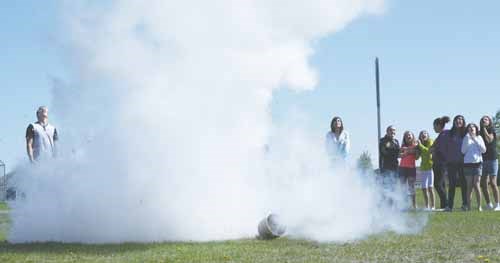A venerable tradition came to an end Friday as Yorkton Regional High School Grade 11 physics students presented science demonstrations for their elementary school counterparts for the last time.
For the past 20 years, Wayne Clark, who teaches Chemistry 20 and Physics 20, has led this project as a means of generating enthusiasm for science at both the senior and junior levels.
"It's good because by demonstrating enthusiasm for science, they also internalize it and develop a greater appreciation for it," he said.
Clark uses a portion of the physics class time for the demonstration program, but, he explained, the new science curriculum being introduced for the 2013-2014 will cut 20 level physics instruction by half.
The curriculum renewal does not represent an overall reduction in science instructional hours, but it shifts content and focus in a way that makes Clark feel the demonstration portion will be unsustainable.
Currently, Grade 11 science offerings include Physics 20, Chemistry 20, Biology 20 and Computer Science 20. The new courses being introduced on a pilot basis in 2013/2014 are Physical Science 20, Health Science 20 and Environmental Science 20. Computer Science remains unchanged.
Physical Science 20 combines the physics and chemistry streams meaning each will receive only 100 instructional hours instead of 200.
In addition to changing the content available to high school science students, the new curriculum represents a shift from the theoretical to the practical.
For example, the introduction to Biology 20 reads: "Biology 20 is the study of life from the molecular level to the biosphere. Through the study of biology, learners are given an opportunity to explore and understand the natural world and to become aware of the profound influence of biology in their lives."
In comparison, the course description for Health Science 20, which replaces Biology 20 as a prerequisite for Biology 30, begins with the question, "Do you want to learn about your own health to be able to make informed personal and career choices?"
Chad Holinaty, superintendent of education for Christ the Teacher Catholic Schools, is excited about the change. He said he expects the new curriculum will make science much more relevant to students, increase awareness of the underlying role of science in all careers and encourage more kids to pursue careers in science.
The new curriculum also seeks to introduce new perspectives, particularly in the area of indigenous knowledge and instructional methods.
The shift in focus is at least partially driven by industry demand, particularly in health and mining.
Following the introduction of the new courses at the 20 level, Grade 12 students will soon also have the option of taking Earth Science 30, a resource-focused offering, which includes hands-on field experience.
The new direction has not generated any public discussion in Saskatchewan yet, but it mirrors a general trend in Canada from fundamental science to commercial science. For example, the National Research Council (NRC), long noted for its contributions to basic science has almost completely changed course. In 2012, NRC scientists published just 200 articles in refereed journals, down from 746 two years earlier.
While business applauds the move, not everybody is happy about it. Critics point out that applied science is not possible without the principles discovered by pure science.
In a letter-to-the-editor to the Globe and Mail, biochemist Reinhart Reithmeier wrote: "To dictate the direction of basic research based on today's needs is incredibly short-sighted. Discovery research shines a light into the future, illuminating the way to endless possibilities."
Clark does not worry that the shift in the science curriculum will have a negative impact, though. He believes the highly gifted individuals who make the big discoveries will always be motivated to do so while for the majority of kids, anything that fosters a lifelong appreciation for science is a good thing.




